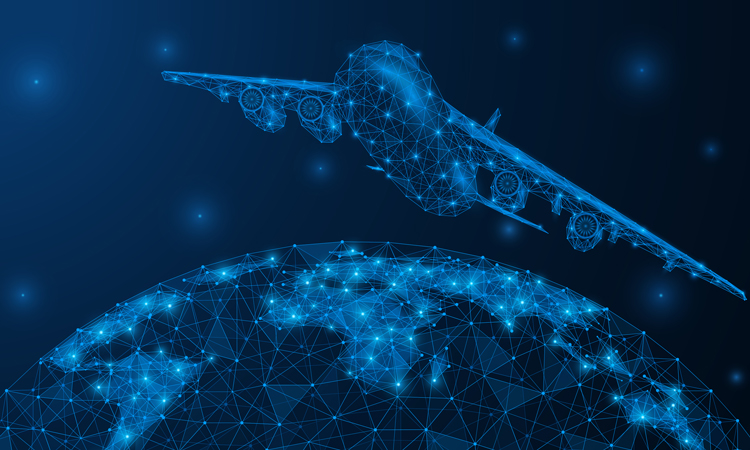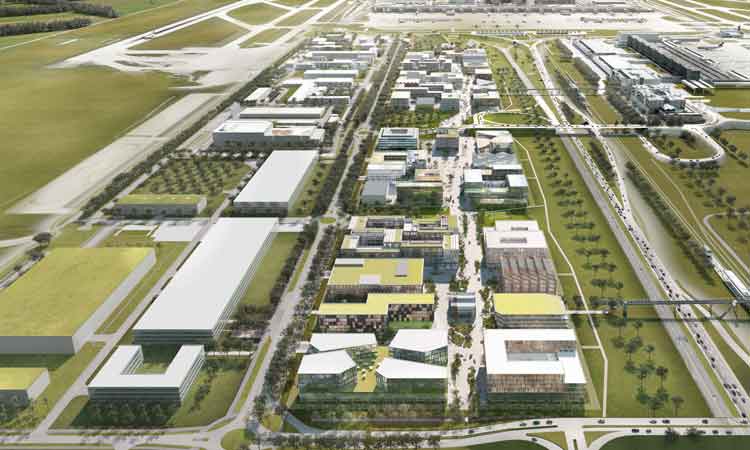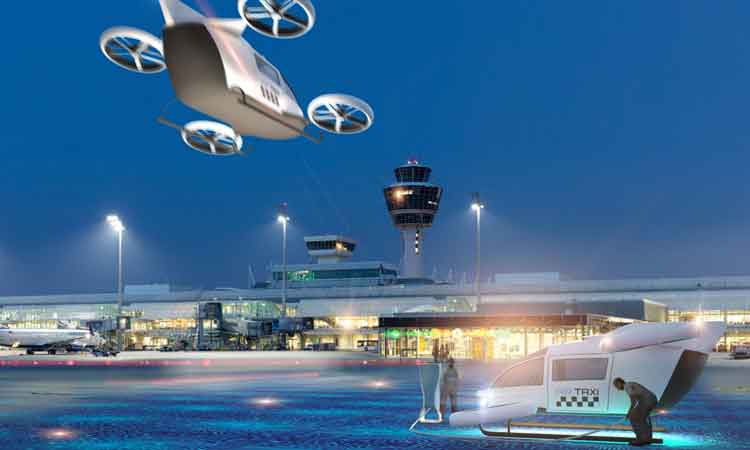The airport as a mobility hub: Imagining an intermodal transportation crossroads for digital innovation and economic growth
- Like
- Digg
- Del
- Tumblr
- VKontakte
- Buffer
- Love This
- Odnoklassniki
- Meneame
- Blogger
- Amazon
- Yahoo Mail
- Gmail
- AOL
- Newsvine
- HackerNews
- Evernote
- MySpace
- Mail.ru
- Viadeo
- Line
- Comments
- Yummly
- SMS
- Viber
- Telegram
- Subscribe
- Skype
- Facebook Messenger
- Kakao
- LiveJournal
- Yammer
- Edgar
- Fintel
- Mix
- Instapaper
- Copy Link
Posted: 13 April 2022 | Sarah Wittlieb | Head of Innovation | Munich Airport | No comments yet
Sarah Wittlieb, Vice President Sales & Innovation, LabCampus GmbH, a subsidiary of Munich Airport, explains why it is a necessity for airports to become a destination in their own right.


For over a century, commercial airports have helped move people and goods quickly across the globe. The infrastructure needed has grown increasingly complex, but the common view of the airport hasn’t evolved much. However, recent trends like a focus on sustainability, future mobility, and the global pandemic1 have demonstrated that it is not only an opportunity – but a necessity – for the airport to become a destination in its own right. This includes becoming an intermodal hub for seamless travel, a crossroads of cross-industry collaboration and digital innovation, and an engine of economic growth driven by the needs of passengers above all else.2
New modes: hyperloops, autonomous vehicles, and air taxis
In the coming decades, new modes of transportation will create more options for passengers – and make travel decisions, logistics, and data handling increasingly complex. Three new modes on the horizon include hyperloops (low-pressure, sealed tube systems where pods can carry passengers or freight at 1,000km/h or faster), autonomous vehicles (private or shared vehicles, buses, and more), and air taxis. The entire customer journey, from planning, booking, and travelling, will grow with geometric complexity. To make informed decisions, passengers will need the right physical environment to transition between modes seamlessly. And they will need apps for planning and ticketing that are not bound by any single company or mode.
Hyperloops raise fears in the aviation industry. The status quo view is that moving people and goods at speeds competitive with air travel creates a pure competitor for the aviation market.3 But, if airports take on the role as intermodal mobility hubs, the zero-sum competition is replaced by airports and their stakeholders benefitting from all transportation forms integrated into the hub.4
Intermodal transportation: from physical to digital crossroads
With the advent of intermodal travel, airports can leverage changes to their benefit by considering the entire customer journey instead of focusing on air travel alone. Although customers may not book their travel from an individual airport application platform, it is important that airports collaborate with service companies to create seamless experiences across a given journey. And this needn’t be as challenging as it sounds. That is because airports have a historical advantage with high stakes, regulated data, and logistics – not something others like road and rail have. This should make it easier for airport stakeholders to create backend integrations and links to offer seamless experiences for customers across all modes of travel.
The entire customer journey, from planning, booking, and travelling, will grow with geometric complexity.
How airports will collaborate with a broad range of partners to provide seamless, digital solutions has yet to be demonstrated. Examples of early systems include passengers at airports such as Boston Logan; they can board some flights at the gate without showing an ID, boarding pass, or interacting with gate staff. Instead, biometric facial recognition is used entering the jet bridge. There is also the co-operation between Lufthansa and Munich Airport, to use text messages or other platforms to communicate departure time, gate, and other updates in near real-time. The expansion of such collaborations and platforms is only limited by the willingness of stakeholders to work together in the interests of improved passenger experience.
One potential way forward could be the use of mobile apps that are not permanently installed on passenger devices, but instead become virtually accessible for a period. In the Android ecosystem, these are called Instant Apps, and on iOS, App Clips.5 Such apps, while just emerging, have the potential to provide services and communication on demand. These would technically be available to passengers – as and when needed – perhaps as a prompt on their phones requesting access. Furthermore, they would not require the customer to discover, install, or delete the app. After all, who does research on, and installs, all the apps available related to every airline, airport, or service they might encounter on a trip? The answer is nobody. But, if airports and their partners can find a way to share data, unified temporary apps could end up offering what it takes a dozen or more proprietary apps to do now. Afterall, in the future, focus won’t be on the share of the profit cake, it will be on the slice you get as partner within a shared data platform.


c: KCAP
The airport as a mobility hub – and engine for economic growth
Airports that become intermodal transportation platforms and hubs will open entire new models for doing business. The fact that they have the space, industrial and logistical expertise, as well as big data skills, not to mention their proximity to educate skilled populations, makes airports well placed to become specific destinations rather than waypoints.
There’s a reason, for instance, why major car companies have been known to stage product release and innovation presentations at airports. All the right ingredients are in place: space, expertise, and real-world customer eyes. It’s this combination that led Audi to showcase its first fully electronic car, the E-Tron, in a 630 square metre space at Munich Airport6, and to demo the integration of e-charging and mobility infrastructure in, and around, the airport with a shuttle service in 2019.7 One can even imagine entire complexes developing out of this. With enough space to provide companies with affordable areas to experiment and innovate both within, and outside of, a lab environment. Adjacent and connected to the airport, with both coalescing together.
A digital innovation hub and a center of excellence
Inspired by the concept of airports becoming intermodal transportation hubs, LabCampus – at Munich Airport – is a 500,000sqm area where a broad range of innovators, across public and private organisations, startups and veterans alike – can collaborate on new services and ideas. The campus represents one vision of how airports become desirable as destinations themselves. With intermodal transportation access to leading tech firms, and a highly educated population of nearly 1.5 million residents of Munich within as little as 30 minutes – LabCampus combines ample space for short and longer-term housing, physical test tracks, and office and meeting space designed to be modular, flexible, and agile. Unlike traditional models, where a company might prototype or test projects at its own headquarters, the LabCampus model lets a business take its prototypes to real customers and includes access to a TestLab based in the airport terminal for residents to hire.
Airports that become intermodal transportation platforms and hubs will open entire new models for doing business.
The LabCampus innovation cosmos is being built in collaboration with the Senseable Lab at Massachusetts Institute of Technology.8 The concepts involves partners across a broad range of disciplines, including Fraunhofer IIS, innosabi GmbH and MUST (Munich Innovation Ecosystem). The first residents are getting ready to move in. ARGO AI is one of them: The company will be building a test-track for its vehicles so that its engineers can seamlessly transition innovative, autonomous driving technologies from simulated environments, to closed courses, to public roads. DFS Deutsche Flugsicherung (DFS), which is responsible for air traffic control in Germany, is another. They will move into the first LabCampus building, LAB 48, in October 2022.


What airports must align on
Munich Airport firmly believes that airports that take on the challenge of becoming intermodal transportation centres, rather than focusing solely on air travel, can become destinations in themselves. They have the potential to become economic engines that are counterparts and partners to their regional urban centres.
To do so, airports must first align themselves with new mobility services – and transform into connected mobility, innovation hubs. To achieve this demands new and updated infrastructure facilities for operations. They will need to go all-in on connected travel platforms that make use of live data about the whole passenger journey. This will involve bringing together information through digital channels and optimising analogue routing for passengers. All of this will require airports to exploit the ecosystem economy to their advantage. But, with their legacy in data and security, they are better placed than other transport competitors to do so.
But it won’t stop there. Once airports become true intermobility hubs – their desirability increases two-fold. Firstly, as a centre of excellence where players and technologies come together at the confluence of travel and innovation, and secondly, as innovation communities. A location with the space, facilities, pioneers, and proximity to foster economic growth.
References
- Bouwer Jaap, Steve Saxon, and Nina Wittkamp: McKinsey & Company (2021) ‘Back to the future? Airline sector poised for change post-COVID-19’, available at: https://www.mckinsey.com/industries/travel-logistics-and-infrastructure/our-insights/back-to-the-future-airline-sector-poised-for-change-post-covid-19 (accessed 23 October, 2021)
- McKinsey & Company (2016) What are the top ten ways airports fail customers?’, available at: https://www.mckinsey.com/business-functions/marketing-and-sales/how-we-help-clients/customer-experience/top-ten-ways-airports-fail-customers (accessed 25 October, 2021)
- Voltes-Dorta, Augusto and Eliad Becker, Elsevier (2018) ‘The potential short-term impact of a Hyperloop service between San Francisco and Los Angeles on airport competition in California’, available at: https://www.sciencedirect.com/science/article/abs/pii/S0967070X17301270?via%3Dihub (accessed October 23, 2021)
- Hardt (2021) Hyperloop can play major role in Schiphol becoming the envisioned sustainable multi-modal hub ‘, available at: https://hardt.global/files/4315/9178/3695/Press_release_Schiphol_study_-_EN.pdf (accessed October 23, 2021)
- Kapersky (2020), ‘What are App Clips and Instant Apps?’, available at: https://www.kaspersky.com/blog/apple-app-clips-android-instant-apps/36040/ (accessed October 18, 2021)
- Audi (2019) ‘Audi e-tron hits Munich Airport with full force’, available at: https://www.audi-mediacenter.com/en/press-releases/audi-e-tron-hits-munich-airport-with-full-force-11229 (accessed October 18, 2021)
- Audi (2018) ‘Audi electrifies Munich: new, free charging, parking and shuttle service at airport’, available at: https://www.audi-mediacenter.com/en/press-releases/audi-electrifies-munich-new-free-charging-parking-and-shuttle-service-at-airport-12198 (accessed October 23, 2021)
- International Airport Review (2018), ‘LabCampus at Munich Airport welcomes MIT in cooperation agreement’, available at: https://www.internationalairportreview.com/news/77420/labcampus-munich-airport-mit/ (accessed October 23, 2021)


Related topics
Airport development, Autonomous Technology, Biometrics, Contactless / Touchless technology, Digital transformation, New technologies, Passenger experience and seamless travel, Security, Sustainability
Related airports
Related organisations
DFS Deutsche Flugsicherung (DFS), Fraunhofer IIS, innosabi GmbH, LabCampus GmbH, Massachusetts Institute of Technology (MIT), MUST (Munich Innovation Ecosystem)


















